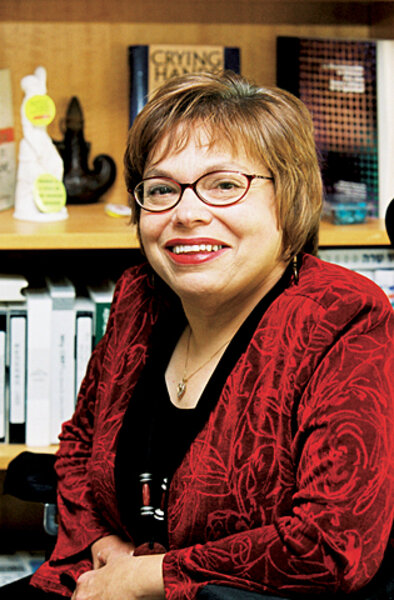Judith Heumann: from 'fire hazard' to top advocate for disabled people
Loading...
| Ottawa
There's a buzz around Judith Heumann. After she appeared as part of a panel – suitably titled "Breaking Barriers" – at an international conference in Ottawa this summer, admirers rushed to "Judy" to thank her for being a torchbearer for disability rights.
Her activism is clearly rooted in a strong sense of justice. Early on she learned that if she wanted to be part of society she was going to have to fight for the right.
"I had no choice because, as a disabled person, I was going to either have to get involved with changing the system that limited me or not participate in society," she says.
In 2010, Ms. Heumann became the first-ever special adviser for international disability rights at the US State Department. Her job: Promote and protect the rights of people with disabilities internationally and ensure that US foreign aid and emergency relief efforts take them and their needs into account.
But Heumann has been breaking down barriers all of her life. Born to Jewish German immigrants in Brooklyn, N.Y., in 1947, she was left paralyzed after being diagnosed with polio at the age of 18 months. She has used a wheelchair most of her life.
In spite of her disability, Heumann's parents had high expectations for their eldest daughter. "You have to have an education," they told her.
Although she was a Brownie and went to Hebrew school, she couldn't understand why going to school with the other kids was off limits. "I was beginning to ask, 'Why am I not going to school? Why am I doing these other things?' " she says.
During that era, disabled children generally were excluded from much of school life. They would either be educated at home or sent to special institutions.
After years of effort by her parents she finally started public school in Grade 4 at age 9. When she was ready for high school, Heumann's mother joined with other mothers to persuade the school board to make the high school more accessible. Heumann was able to attend.
She went on to study speech and theater at Long Island University and set her heart on becoming a teacher.
But when she applied to the New York City Board of Education, she was rejected on the basis that, because she was in a wheelchair, she could be a fire hazard.
In what became a landmark ruling, she sued the school board and won – becoming the first person in a wheelchair to teach in New York City.
While in college in the late 1960s, Heumann had joined in civil rights and antiwar protests, but she also organized disability rights rallies and protests.
"We were looking to change society, flip it over," Heumann says.
In 1970, Heumann and some friends founded Disability in Action, a group aimed at addressing barriers to employment, housing, and education. She brought her can-do attitude to Berkeley, Calif., and cofounded the country's first Center for Independent Living (CIL).
"She was absolutely sure that she should have the right to live like everybody else," says Joan Leon, a fellow disability rights activist. "She was instrumental in building CIL. She gave it legs."
Today, the Berkeley CIL serves as a model for other independent living centers in more than 60 countries.
In 1977, Heumann helped organize a sit-in at the Department of Health, Education, and Welfare office in San Francisco. That protest, along with others nationwide, resulted in the implementation of Section 504 of the 1973 Rehabilitation Act, which made it illegal for federally funded programs to discriminate against disabled people.
Heumann also has helped craft legislation herself, such as the Individuals with Disabilities Education Act. And she's worked in senior posts in the Department of Education and at the World Bank.
Heumann is "a woman who laid the groundwork for basic rights, like access to education and employment," says Helena Berger, chief operating officer of the nonprofit American Association of People with Disabilities.
Today, Heumann speaks up not only for Americans with disabilities, but for the 1 billion disabled people worldwide (according to World Health Organization/World Bank estimates).
Rights for people with disabilities have come a long way – now it's "much different than what it was when I was growing up," she says.
But more needs to be done, she says. The jobless rate among disabled people stands at 15 percent, according to the US Department of Labor – one-third higher than for the general public. And people with disabilities are twice as likely as other Americans to be victims of violence, according to a 2008 Bureau of Justice Statistics report.
Heumann is convinced that breaking barriers for disabled people brings benefits for everybody.
"Once ... [disabled and nondisabled] people have opportunities to be with each other," she says, "they begin to have a much better understanding of the equality – and the benefit – of all people being together."
• October is National Disability Employment Awareness Month, which raises awareness about disability employment issues and celebrates the contributions of workers with disabilities. For more information, go to: www.dol.gov/odep
• To read other stories about people making a difference, go here.





